This article needs additional citations for verification .(April 2007) |
Airdrie Public Library is a public library in Airdrie, North Lanarkshire, Scotland. The library has been housed in a number of buildings since its founding.
This article needs additional citations for verification .(April 2007) |
Airdrie Public Library is a public library in Airdrie, North Lanarkshire, Scotland. The library has been housed in a number of buildings since its founding.




The history of the library dates back to the 1850s when the town adopted the Public Libraries Act. Its first home was a room in the town hall, or Town House as it was called. From 1860 it moved a number of times until the opening of its current home in 1925.
There have been two buildings purpose-built for the library. The first was opened in 1894 by a public subscription of more than £1000 and a £1000 donation from Andrew Carnegie (the Scottish born philanthropist) on Anderson Street, today's Airdrie Arts Centre. MP Sir John Wilson gave a further £1000 to write off accompanying debt.
Unusually, the library has shared a common history with an observatory. Airdrie Public Observatory was founded in this building in 1896.
The 1894 building proved too small. The second purpose-built, and current, building was designed by JM Arthur, [1] and opened on 25 September 1925, funded by Airdrie Savings Bank and a second Carnegie grant. [2] The local newspaper, the Airdrie and Coatbridge Advertiser had this to say the next day; "Although not quite finished the new Library building in Wellwynde Street was sufficiently far advanced towards completion to allow the opening ceremony to take place yesterday afternoon".
The observatory moved along with the library, a purpose-built observatory being built on the library roof and a brass 6-inch (150 mm) refracting telescope was obtained by the observatory curator Ex-Baillie James Lewis for the sum of £500. The original Dr Reid telescope was also brought from the old observatory.
In 1920, the library was gifted a Covenanters' flag, carried in the Battle of Bothwell Bridge, by John Main, Laird of Ballochney. The flag suffered degradation due to light exposure, but underwent restoration, completed in 2002, and was re-displayed. [3]
In August the Public Libraries Act (Scotland) was passed, and in November Airdrie was the first Scottish town to adopt it, beating Dunfermline into second place by 13 years.
A quantity of books were obtained for the sum of £40 from the Institution of Mechanical Engineers and the Library opened in the clerks office in the Town House, now known as the Town Clock.
Andrew Carnegie had promised in a letter to Mr Thomas Jeffrey of Airdrie Savings Bank an amount of money equaling £1,000 (being half of the money required to build a new library) so long as a piece of land was acquired and the other half of the money was raised locally. On receiving this guarantee, a public appeal was launched on 13 June 1892 for funds, and by October 1892 more than £1,000 had been raised. With more than £2,000, plans were drawn up to build the new Library on Anderson Street.
The new library was opened and MP Sir John Wilson wrote off some accompanying debt to the amount of £1,000 which allowed the new library to operate debt free from then on.
Dr. Thomas Reid, an eminent Glasgow oculist, donated a 3-inch (76 mm) brass-bodied, refracting telescope to the town, and it was housed in the library. He also donated the sum of £35 to convert a top-floor room, where a dome was built on the roof of the building for it. Thus founding Airdrie Public Observatory. Robert Dunlop was the first Honorary Curator, followed shortly by Mr Peter Scotland.
A new library was built near the first purpose-built library with financial assistance from Airdrie Savings Bank and a second grant from the Carnegie United Kingdom Trust. A new purpose-built observatory was built on the library roof. It is currently curated by Airdrie Astronomical Association (AAA) [4]

Airdrie is a town in North Lanarkshire, Scotland. It lies on a plateau roughly 400 ft above sea level, and is approximately 12 miles (19 km) east of Glasgow city centre. As of 2012, the town had a population of around 37,130. Historically part of Lanarkshire, Airdrie forms part of a conurbation with its neighbour Coatbridge, in what is commonly known as the Monklands, formerly a district, having a population of approximately 90,000 including outlying settlements.

The Lick Observatory is an astronomical observatory owned and operated by the University of California. It is on the summit of Mount Hamilton, in the Diablo Range just east of San Jose, California, United States. The observatory is managed by the University of California Observatories, with headquarters on the University of California, Santa Cruz campus, where its scientific staff moved in the mid-1960s. It is named after James Lick.

The Paris Observatory, a research institution of the Paris Sciences et Lettres University, is the foremost astronomical observatory of France, and one of the largest astronomical centers in the world. Its historic building is on the Left Bank of the Seine in central Paris, but most of the staff work on a satellite campus in Meudon, a suburb southwest of Paris.
Boyden Observatory is an astronomical research observatory and science education centre located in Maselspoort, 20 kilometres (12 mi) north-east of the city of Bloemfontein in Free State, South Africa. The observatory is managed by the Physics Department of the University of the Free State (UFS). The Friends of Boyden assist the observatory as a public support group, organising open evenings and protecting its public interest. Boyden also makes use of members of ASSA Bloemfontein Centre, the amateur astronomy club of the city, for presenters and telescope assistants.

Leiden Observatory is an astronomical institute of Leiden University, in the Netherlands. Established in 1633 to house the quadrant of Rudolph Snellius, it is the oldest operating university observatory in the world, with the only older still existing observatory being the Vatican Observatory.
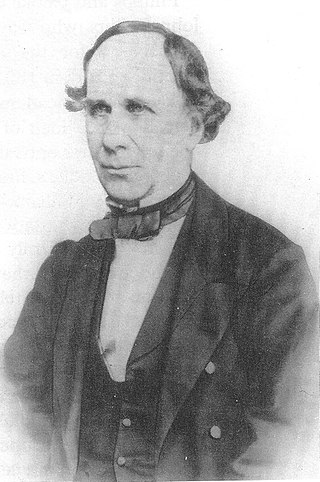
Thomas Cooke was a British scientific instrument maker based in York. He founded T. Cooke & Sons, the scientific instrument company.

The Pulkovo Astronomical Observatory, officially named the Central Astronomical Observatory of the Russian Academy of Sciences at Pulkovo, is the principal astronomical observatory of the Russian Academy of Sciences. It is located 19 km south of Saint Petersburg on Pulkovo Heights 75 metres (246 ft) above sea level. It is part of the UNESCO World Heritage Site Historic Centre of Saint Petersburg and Related Groups of Monuments. It was formerly known as the Imperial Observatory at Pulkowo.
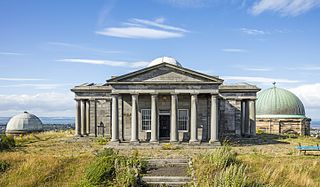
The City Observatory was an astronomical observatory on Calton Hill in Edinburgh, Scotland. It is also known as the Calton Hill Observatory.

The James Lick Telescope is a refracting telescope built in 1888. It has a lens 91 centimetres (36 in) in diameter—a major achievement in its day. The instrument remains in operation and public viewing is allowed on a limited basis. Also called the "Great Lick Refractor" or simply "Lick Refractor", it was the largest refracting telescope in the world until 1897 and now ranks third, after the 40-inch refractor at the Yerkes Observatory and the Swedish 1-m Solar Telescope. The telescope is located at the University of California's Lick Observatory atop Mount Hamilton at an elevation of 1,283 metres (4,209 ft) above sea level. The instrument is housed inside a dome that is powered by hydraulic systems that raise and lower the floor, rotate the dome and drive the clock mechanism to track the Earth's rotation. The original hydraulic arrangement still operates today, with the exception that the original wind-powered pumps that once filled the reservoirs have been replaced with electric pumps. James Lick is entombed below the floor of the observing room of the telescope.
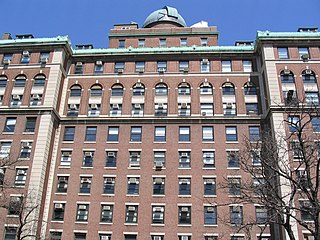
Rutherfurd Observatory is the astronomical facility maintained by Columbia University named after Lewis Morris Rutherfurd. Initially, Rutherfurd housed its telescopes and equipment in midtown Manhattan and later on the Stuyvesant Estate. When the Morningside campus was built, telescopes were kept in a "transit building" where the Interdisciplinary Science Building now stands. When Pupin Physics Laboratories were completed in 1927, the home of the observatory was moved to the top of the building. Below the Rutherfurd Observatory on the 14th floor was the site of Professor Wallace Eckert's Astronomical Laboratory, in which he constructed the first device to perform general scientific calculations automatically in 1933-34.

The Archenhold Observatory was named in honour of Friedrich Simon Archenhold, is an observatory in Berlin-Treptow. It houses the Großer Refraktor, which is the longest pointable telescope in the world. It is also called Die Himmelskanone.
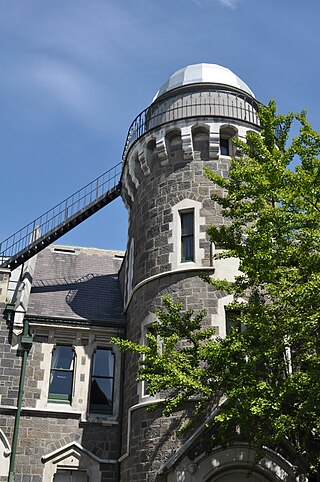
Townsend Observatory, owned and administered by the University of Canterbury, is part of the Arts Centre of Christchurch, New Zealand and was open on clear Friday evenings. The building collapsed in the February 2011 Christchurch earthquake.

Airdrie Public Observatory is a fully operational, historic astronomical observatory, which is part of the library building in the town of Airdrie, North Lanarkshire, Scotland. There are only four public observatories operating in the United Kingdom, all of which are in Scotland. Airdrie Observatory is the smallest, and second oldest.

Mills Observatory is the first purpose-built public astronomical observatory in the UK, located in Dundee, Scotland. Built in 1935, the observatory is classically styled in sandstone and has a distinctive 7 m dome, which houses a Victorian refracting telescope, a small planetarium, and display areas. The dome is one of two made from papier-mâché to survive in the UK, the other being at the Godlee Observatory.

Coats Observatory is Scotland's oldest public observatory. It is currently closed for refurbishment as part of a 4-year long £42m transformation of the observatory and museum buildings. Located in Oakshaw Street West, Paisley, Renfrewshire, the observatory has been operational since 1 October 1883 and continues to function to this day, offering visitors the opportunity to view the night sky through the powerful telescopes housed within the building. The observatory is currently closed for redevelopment and is due to reopen in 2023.

Fuertes Observatory is an astronomical observatory located on the North Campus of Cornell University in Ithaca, New York. The observatory was designed by L.P. Burnham, Cornell Professor of Architecture and completed in fall of 1917. It was originally used by the Civil Engineering Department as an instructional field office for navigation and surveying. Today, the observatory is primarily used for public outreach, welcoming over two thousand visitors per year with open houses on clear Friday nights.
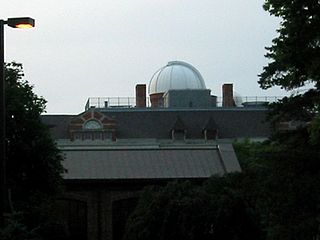
Sherzer Observatory is an astronomical observatory located on the campus of Eastern Michigan University. The observatory was established in 1903 with the construction of the new Natural Science Building, in Ypsilanti, Michigan. Following a devastating fire in 1989 a new observatory opened in September 1991 with a 10-inch (250 mm) apochromatic refractor telescope and German equatorial mount centered under a 6-meter dome.

The Observatory of the rue Serpente was an astronomical observatory owned and operated by the Société Astronomique de France in the historic Latin Quarter of Paris. It operated between 1890 until 1968, when it was transferred to a new location at the nearby Astronomy Tower of the Sorbonne.

The Hume Cronyn Memorial Observatory is a public astronomical observatory located on the campus of the University of Western Ontario, in London, Ontario, Canada.
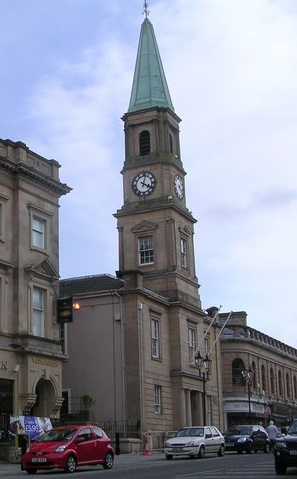
Airdie Town House is a municipal building in Bank Street, Airdrie, North Lanarkshire, Scotland. The town house, which was the headquarters of Airdrie Burgh Council, is a Category B listed building.